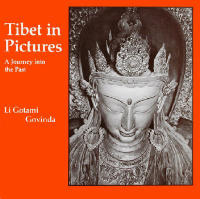 Tibet in Pictures
Tibet in Pictures

This exquisite and unique collection now reprint in one volume, in addition to illustrating the people and the country, preserves, in two-hundred black and white photographs, more than fifty works of the sacred art now largely lost to the world
|
|
Excerpt From The Pages Of Tibet in Pictures
From "Avalokiteshvara, White Temple, Tsaparang": (Text accompaning a photograph of the statue of Avalokiteshvara) Avalokiteshvara is the active aspect of Buddha Amitabha (Buddha of Infinite Light), and the embodiment of his compassion. He appears in different forms, with two arms, four arms, or a thousand arms which are usually arranged like a halo around his white body, and symbolize his readiness to help all living beings who call upon him. The most popular Tibetan form of Avalokiteshvara is the one with four arms depicted here. The two central hands hold the jewel (mani) that is referred to in his mantra, OM MANI PADME HUM. The left back hand holds a flower, while the right back hand holds a rosary. It is believed that Avalokiteshvara, the Compassionate One, looking down upon the misery and suffering of the world, shed a tear of compassion, out of which was born the merciful Tara or Dolma, the Savioress. In China and Japan, Avalokiteshvara is generally depicted as a female, called Kwanyin in China, and Kannon in Japan. In Tibet, Avalokiteshvara, the patron saint, is known as Chenrezig. |